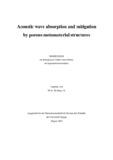Citation link:
http://dx.doi.org/10.25819/ubsi/10503Files in This Item:
| File | Description | Size | Format | |
|---|---|---|---|---|
| Dissertation_Liu_Qi-hang.pdf | 8.47 MB | Adobe PDF |  View/Open |
| Dokument Type: | Doctoral Thesis | metadata.dc.title: | Acoustic wave absorption and mitigation by porous metamaterial structures | Other Titles: | Absorption und Abschwächung akustischer Wellen durch poröse Metamaterialstrukturen | Authors: | Liu, Qi-hang | Institute: | Lehrstuhl für Baustatik | Free keywords: | Acoustic wave, Sound absorption and mitigation, Porous materials, Metamaterials, Akustische Welle, Schallabsorption und -minderung, Poröse Materialien, Metamaterialien | Dewey Decimal Classification: | 624 Ingenieurbau und Umwelttechnik | GHBS-Clases: | WDO | Issue Date: | 2024 | Publish Date: | 2024 | Abstract: | Efficient noise control is an important and crucial issue in a wide range of engineering applications. Porous materials with dispersed micro-pores are commonly used due to their high capacity to absorb acoustic wave energy and mitigate undesirable noises. This thesis aims to improve the low-frequency sound absorption performance in a broad frequency range. For this purpose, two porous metamaterial (PM) structures are proposed, namely, the slit-perforated multi-layered porous metamaterial (SMPM) structure and the novel multiscale porous metamaterial (MPM) structure. The SMPM structure consists of periodic porous matrix layers and second-type porous layers with periodically distributed slits, while the novel MPM structure consists of a porous matrix with periodically distributed meso-pores, in which a second porous layer is introduced as an interlayer between the matrix and the meso-pores. Theoretical models based on the homogenization schemes and semi-phenomenological approaches to describe the macroscopic dynamic properties of the porous materials are adopted, while numerical methods based on the transfer matrix method (TMM) and the finite element method (FEM) are applied to compute the acoustic wave absorption and mitigation characteristics of the proposed PM structures in both room-temperature and high-temperature environments. In particular, the band structures or dispersion curves especially the frequency bandgaps, and the acoustic wave absorption coefficients are analyzed and discussed in details. The research findings and the knowledge gained in this thesis may provide a deep insight into the acoustic wave absorption and mitigation characteristics and the corresponding physical mechanisms in porous metamaterial structures, which are highly valuable for the design, optimization, realization and application of novel porous metamaterial structures Effiziente Lärmdämmung ist eine wichtige und entscheidende Angelegenheit in einer Vielzahl von Ingenieuranwendungen. Poröse Materialien mit verteilten Mikroporen werden aufgrund ihrer hohen Kapazität zur Absorption von Schallwellenenergie und zur Minderung unerwünschter Geräusche häufig eingesetzt. Diese Dissertation zielt darauf ab, die Schallabsorptionsleistung bei niedrigen Frequenzen in einem breiten Frequenzbereich zu verbessern. Zu diesem Zweck werden zwei poröse Metamaterialstrukturen (PM-Strukturen) vorgeschlagen, nämlich die geschlitzt-perforierte mehrschichtige poröse Metamaterialstruktur (SMPM-Struktur) und die neuartige mehrskalige poröse Metamaterialstruktur (MPM-Struktur). Die SMPM-Struktur besteht aus periodischen porösen Matrixschichten und porösen Schichten des zweiten Typs mit periodisch verteilten Schlitzen, während die neuartige MPM-Struktur aus einer porösen Matrix mit periodisch verteilten Mesoporen besteht, in die eine zweite poröse Schicht als Zwischenschicht zwischen der Matrix und den Mesoporen eingeführt wird. Theoretische Modelle, die auf den Homogenisierungsschemata und semi-phenomenologischen Ansätzen zur Beschreibung der makroskopischen dynamischen Eigenschaften der porösen Materialien basieren, werden verwendet, während numerische Methoden auf Basis der Transfer-Matrix-Methode (TMM) und der Finite-Elemente-Methode (FEM) angewendet werden, um die akustischen Wellenabsorptions- und Dämpfungseigenschaften der vorgeschlagenen PM-Strukturen sowohl bei Raumtemperatur als auch bei Hochtemperaturumgebungen zu berechnen. Insbesondere werden die Bandstrukturen oder Dispersionskurven, insbesondere die Frequenzbandlücken, sowie die Absorptionskoeffizienten für akustische Wellen im Detail analysiert und diskutiert. Die Forschungsergebnisse und das in dieser Dissertation gewonnene Wissen können einen tiefen Einblick in die akustischen Wellenabsorptions- und Dämpfungseigenschaften sowie die entsprechenden physikalischen Mechanismen in porösen Metamaterialstrukturen bieten, was äußerst wertvoll für die Gestaltung, Optimierung, Realisierung und Anwendung neuartiger poröser Metamaterialstrukturen ist. |
DOI: | http://dx.doi.org/10.25819/ubsi/10503 | URN: | urn:nbn:de:hbz:467-27166 | URI: | https://dspace.ub.uni-siegen.de/handle/ubsi/2716 | License: | http://creativecommons.org/publicdomain/zero/1.0/ |
| Appears in Collections: | Hochschulschriften |
This item is protected by original copyright |
Page view(s)
269
checked on Jul 12, 2024
Download(s)
107
checked on Jul 12, 2024
Google ScholarTM
Check
Altmetric
This item is licensed under a Creative Commons License


